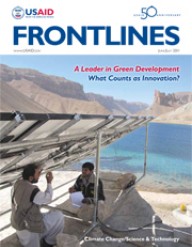A few years ago, I traveled to northern India to visit with a rural farming community, where about 30 percent of the children were chronically malnourished, and, therefore, stunted. The farmers faced increasingly difficult conditions as hotter, drier growing conditions had come to mean less food, lower incomes, and more poverty across the region. The children did not go to school, and their parents struggled every night to put food on the table.
At one point, struck by the visible poverty around me, I asked a group of farmers whether they had cell phones. I could tell immediately that they were deeply offended.
“Even the goat herders have cell phones,” they said. “And we’re farmers.”
The wide reach of cell phones has given us one of the most powerful development platforms ever. In northern India, farmers can now get real-time market price information and agricultural advice, and in Haiti, entrepreneurs can access safe and reliable mobile banking services.
Twenty years ago, no one could have predicted that cell phones would become the next transformative development innovation. No one could have told you that the fastest growing market for cell phones in 2011 would be sub-Saharan Africa. No one could have guessed that more people in Africa than in America would have cell phones.
What actually happened across the past two decades to make this a reality? The spread of cell phones demonstrated an effective development path that is often followed by breakthroughs in science and technology.
Along with cell phone technology becoming cheaper, we also saw improved governance, private-sector reforms, and economic growth in Africa. In fact, African incomes grew at a faster rate than many developed world economies. Telecom companies built cell phone towers instead of fixed lines, and rapidly connected a continent where only one-third of the population had access to electricity.
The curve of cell phone distribution did not progress in a linear fashion. It bent upwards, dramatically. We must approach development with a similar mindset. Rather than achieve incremental gains by following the status quo, we have to bend the curve of progress in order to deliver cost-efficient, meaningful results.
This is why we are seeking new ways to reward innovation and harness the transformative power for science and technology. This embrace of innovation forms the foundation of a new series of Grand Challenge partnerships that we introduced earlier this year. Our first Grand Challenge—called Saving Lives at Birth—called on a range of partners to develop new, groundbreaking solutions to prevent maternal and child deaths in regions where mothers will likely never see a hospital.
Over 600 innovators have answered this first call. Nearly half of the proposals came from outside the United States, and more than a quarter were received from developing countries. Each one has the potential to be the next breakthrough in maternal and infant health.
Today, several global trends have aligned, giving us an unprecedented opportunity to bend the curve of development progress. Combined with growing private sector engagement and the spread of democracy, rapid technological change has spurred new opportunities to accelerate growth, strengthen governance, and attend to human needs. Now, it is up to us to seize these opportunities and transform them into real results for developing countries.









Comment
Make a general inquiry or suggest an improvement.